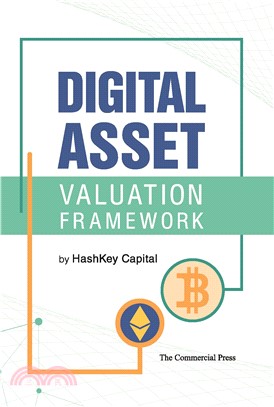Digital Asset Valuation Framework
商品資訊
ISBN13:9789620767340
出版社:香港商務印書館
作者:HashKey Capital
出版日:2024/07/08
裝訂/頁數:精裝/256頁
規格:21cm*14cm (高/寬)
定價
:NT$ 1210 元優惠價
:90 折 1089 元
海外經銷商無庫存,到貨日平均30天至45天
下單可得紅利積點:32 點
商品簡介
作者簡介
序
目次
相關商品
商品簡介
【核心賣點】The most updated guidance provides the valuation framework for digital asset, cryptocurrencies.
【一句話推介】Level up your crypto investment with analytical rigour and understanding.
【內容簡介】The author outlines a framework that evaluate different crypto assets consistently. Successful crypto investing requires a solid framework for value-based decisions rather than speculation. Hopefully, it can bring some clarity to the industry and help to understand the intrinsic value of crypto assets.
【一句話推介】Level up your crypto investment with analytical rigour and understanding.
【內容簡介】The author outlines a framework that evaluate different crypto assets consistently. Successful crypto investing requires a solid framework for value-based decisions rather than speculation. Hopefully, it can bring some clarity to the industry and help to understand the intrinsic value of crypto assets.
作者簡介
HashKey Capital is a global digital asset and blockchain leader helping institutions, founders and talents advance the blockchain industries.
As one of the largest crypto funds and the earliest institutional investor in Ethereum, HashKey Capital has over US$1 billion AUM since its inception, with over 500 investments in infrastructure, tools, and applications.
With our deep knowledge across the blockchain ecosystem, HashKey Capital has built a robust network connecting founders, investors, developers, and regulators.
As one of the largest crypto funds and the earliest institutional investor in Ethereum, HashKey Capital has over US$1 billion AUM since its inception, with over 500 investments in infrastructure, tools, and applications.
With our deep knowledge across the blockchain ecosystem, HashKey Capital has built a robust network connecting founders, investors, developers, and regulators.
序
序
From the initial birth of Bitcoin in 2008 to the present day, blockchain technology and the cryptocurrency market have been rapidly evolving, becoming a powerful force in the global financial realm. There is a strong interest and great attention towards this new type of asset known as cryptocurrency. The approval of 11 Bitcoin spot ETFs by SEC in early 2024 further signifies the formal shift of cryptocurrencies from the periphery to the mainstream. Investors can now trade Bitcoin like stocks, transforming it into an asset that traditional investors can comprehend.
Although cryptocurrencies have been in existence for several years, they are still an early-stage industry, both in terms of technological development and asset management. Cryptocurrencies differ from mainstream assets in that the value of most cryptocurrencies is derived from consensus rather than a standardised valuation framework. These consensus-based cryptocurrencies have created both wealth effects and some scepticism from the mainstream. Questions arise, such as why cryptocurrencies hold value, whether Bitcoin has any underlying support, what drives cryptocurrency prices, and what reasons there are to invest in cryptocurrencies. However, as the industry gradually matures, we are discovering that traditional financial valuation methods can be applied to the valuation of cryptocurrencies. This enables traditional institutional investors to understand the industry, attracting more capital and giving rise to more unicorns, similar to what happened in the internet and consumer industries.
At this momentous time when Bitcoin spot ETFs have been approved in the United States, and a new bull market is on the horizon, HashKey Capital has decided to write this book. HashKey Capital is a venture capital that has been deeply involved in blockchain investments for nearly a decade. We have invested in over 500 projects covering various sectors of the industry, with the aim of capturing value across the entire ecosystem. Throughout this journey, we have focused on ecosystem development, developer support, and project investments, growing alongside the industry. Our understanding has continuously improved as we leverage our insights and investment logic from the primary market, combining traditional financial experience with blockchain and cryptocurrency investment activities. This has led us to develop a framework for valuing cryptocurrency assets. We now share this valuation framework, hoping to provide reliable valuation methods for cryptocurrency investors.
As one size doesn’t fit all, the digital asset valuation framework outlined in this book provides guidance to evaluate any asset within the framework.
First, we categorise the different types of crypto assets with the help of our token categorisation tree.
Second, we apply the token valuation matrix that allows us to identify a token valuation method that fits the crypto asset that one is trying to evaluate.
Third, we apply the token valuation method to the token being evaluated.
For clarity, this book aims to bring a crypto asset valuation and not an evaluation. People use the words valuation and evaluation interchangeably, but some important differences exist. Evaluation refers to assessing something; for example, evaluate if a product is good, evaluate a brand, evaluate how tasty the food is in that new Michelin restaurant or the potential of a certain investment return. On the other hand, valuation refers specifically to determining an asset’s financial value. Valuation involves analysing data to determine the value of an asset. In this book, we focus on the second.
It is also important to say that valuation and prices reflect two different things. While valuation represents the intrinsic value of something, the price is the result of many other variables that often differs from the value: sentiment, market hype or depression, speculation, fear, greed, overinflated news, etc. We can affirm that the prices of most assets in the world have a non-negligible percentage of irrationalism, but crypto sometimes suffers from this disorder to a higher degree. Specifically, there are many factors that can influence cryptocurrency prices, including market demand, market sentiment, government policies, regulatory changes, technological innovations, industry partnerships, project progress, and so on.
Throughout this book, the reader will stumble upon valuation methods that might provide indicative price projections. Still, it’s important to note that these price projections are based on valuation metrics that encompass a small number of variables. Consequently, when applying these metrics, one always needs to take into account that there are many other “ceteris paribus” variables.
Long-term successful investing in crypto doesn’t require an unusual IQ , special business insights, or insider information. Instead, what’s needed is a solid framework for making investment decisions based on value rather than speculation.
We sincerely hope that this book can provide you with assistance in your crypto asset investments, answer your questions, and offer support and guidance. As you read through this book, we hope you can deeply engage with its content and enjoy the journey of cryptocurrency investment. We wish you a pleasant reading experience!
From the initial birth of Bitcoin in 2008 to the present day, blockchain technology and the cryptocurrency market have been rapidly evolving, becoming a powerful force in the global financial realm. There is a strong interest and great attention towards this new type of asset known as cryptocurrency. The approval of 11 Bitcoin spot ETFs by SEC in early 2024 further signifies the formal shift of cryptocurrencies from the periphery to the mainstream. Investors can now trade Bitcoin like stocks, transforming it into an asset that traditional investors can comprehend.
Although cryptocurrencies have been in existence for several years, they are still an early-stage industry, both in terms of technological development and asset management. Cryptocurrencies differ from mainstream assets in that the value of most cryptocurrencies is derived from consensus rather than a standardised valuation framework. These consensus-based cryptocurrencies have created both wealth effects and some scepticism from the mainstream. Questions arise, such as why cryptocurrencies hold value, whether Bitcoin has any underlying support, what drives cryptocurrency prices, and what reasons there are to invest in cryptocurrencies. However, as the industry gradually matures, we are discovering that traditional financial valuation methods can be applied to the valuation of cryptocurrencies. This enables traditional institutional investors to understand the industry, attracting more capital and giving rise to more unicorns, similar to what happened in the internet and consumer industries.
At this momentous time when Bitcoin spot ETFs have been approved in the United States, and a new bull market is on the horizon, HashKey Capital has decided to write this book. HashKey Capital is a venture capital that has been deeply involved in blockchain investments for nearly a decade. We have invested in over 500 projects covering various sectors of the industry, with the aim of capturing value across the entire ecosystem. Throughout this journey, we have focused on ecosystem development, developer support, and project investments, growing alongside the industry. Our understanding has continuously improved as we leverage our insights and investment logic from the primary market, combining traditional financial experience with blockchain and cryptocurrency investment activities. This has led us to develop a framework for valuing cryptocurrency assets. We now share this valuation framework, hoping to provide reliable valuation methods for cryptocurrency investors.
As one size doesn’t fit all, the digital asset valuation framework outlined in this book provides guidance to evaluate any asset within the framework.
First, we categorise the different types of crypto assets with the help of our token categorisation tree.
Second, we apply the token valuation matrix that allows us to identify a token valuation method that fits the crypto asset that one is trying to evaluate.
Third, we apply the token valuation method to the token being evaluated.
For clarity, this book aims to bring a crypto asset valuation and not an evaluation. People use the words valuation and evaluation interchangeably, but some important differences exist. Evaluation refers to assessing something; for example, evaluate if a product is good, evaluate a brand, evaluate how tasty the food is in that new Michelin restaurant or the potential of a certain investment return. On the other hand, valuation refers specifically to determining an asset’s financial value. Valuation involves analysing data to determine the value of an asset. In this book, we focus on the second.
It is also important to say that valuation and prices reflect two different things. While valuation represents the intrinsic value of something, the price is the result of many other variables that often differs from the value: sentiment, market hype or depression, speculation, fear, greed, overinflated news, etc. We can affirm that the prices of most assets in the world have a non-negligible percentage of irrationalism, but crypto sometimes suffers from this disorder to a higher degree. Specifically, there are many factors that can influence cryptocurrency prices, including market demand, market sentiment, government policies, regulatory changes, technological innovations, industry partnerships, project progress, and so on.
Throughout this book, the reader will stumble upon valuation methods that might provide indicative price projections. Still, it’s important to note that these price projections are based on valuation metrics that encompass a small number of variables. Consequently, when applying these metrics, one always needs to take into account that there are many other “ceteris paribus” variables.
Long-term successful investing in crypto doesn’t require an unusual IQ , special business insights, or insider information. Instead, what’s needed is a solid framework for making investment decisions based on value rather than speculation.
We sincerely hope that this book can provide you with assistance in your crypto asset investments, answer your questions, and offer support and guidance. As you read through this book, we hope you can deeply engage with its content and enjoy the journey of cryptocurrency investment. We wish you a pleasant reading experience!
目次
Table of Contents
Preface
About HashKey Capital
Introduction
Token Categories
Chapter 1 Valuation of Native Cryptocurrencies
1.1 The value of a trusted decentralised network replacing centralised financial institutions
1.2 Bitcoin comparison with telecommunication networks
1.3 Hallmarks of value and equilibrium of a decentralised network of assets
1.4 Bitcoin’s Moore Law Compensation
1.5 Bitcoin price equilibrium adjusted to M2
1.6 Bitcoin Stock-to-Flow Model
1.7 Bitcoin P/S ratios
1.8 Bitcoin comparison with gold ETF
1.8.1 Bitcoin - “Digital Gold”
1.8.2 The Institutionalisation of the Gold Market
1.8.3 The Impact of Gold ETFs on Gold Prices
1.8.4 Bitcoin ETFs
1.8.5 Bitcoin price projection from the Bitcoin ETFs outlook
1.9 Cost of production method
1.10 Transaction value to transaction fee
Chapter 2 Public Chain/Layer 1 Valuati
2.1 DCF – Discounted Cash Flow
2.2 Calculating Discounted Cash Flow Method (DCF)
2.3 Calculating the price equilibrium for Ethereum
2.4 Value of a perpetual bond
2.5 Metcalfe’s Law
2.6 NVT Ratio
2.7 NVT calculation
2.8 P/S Ratio
Chapter 3 DAO Tokens and Utility Tokens
3.1 Market approach
3.2 Comparable tokens
3.3 QTM – Quantity Theory of Money
3.4 Market capitalisation/TVL ratio
Chapter 4 A Framework for DAO Token Valuation
4.1 Voting premium
4.2 Net Current Asset Value Per Token (NCAVPT)
4.3 Transparency and governance premium
Chapter 5 STO Valuation
5.1 Income-based Approach
5.2 The Relative Valuation Method
5.3 Cost Approach
Chapter 6 NFT Valuation
6.1 Valuation Matrix of NFT
Conclusion
Preface
About HashKey Capital
Introduction
Token Categories
Chapter 1 Valuation of Native Cryptocurrencies
1.1 The value of a trusted decentralised network replacing centralised financial institutions
1.2 Bitcoin comparison with telecommunication networks
1.3 Hallmarks of value and equilibrium of a decentralised network of assets
1.4 Bitcoin’s Moore Law Compensation
1.5 Bitcoin price equilibrium adjusted to M2
1.6 Bitcoin Stock-to-Flow Model
1.7 Bitcoin P/S ratios
1.8 Bitcoin comparison with gold ETF
1.8.1 Bitcoin - “Digital Gold”
1.8.2 The Institutionalisation of the Gold Market
1.8.3 The Impact of Gold ETFs on Gold Prices
1.8.4 Bitcoin ETFs
1.8.5 Bitcoin price projection from the Bitcoin ETFs outlook
1.9 Cost of production method
1.10 Transaction value to transaction fee
Chapter 2 Public Chain/Layer 1 Valuati
2.1 DCF – Discounted Cash Flow
2.2 Calculating Discounted Cash Flow Method (DCF)
2.3 Calculating the price equilibrium for Ethereum
2.4 Value of a perpetual bond
2.5 Metcalfe’s Law
2.6 NVT Ratio
2.7 NVT calculation
2.8 P/S Ratio
Chapter 3 DAO Tokens and Utility Tokens
3.1 Market approach
3.2 Comparable tokens
3.3 QTM – Quantity Theory of Money
3.4 Market capitalisation/TVL ratio
Chapter 4 A Framework for DAO Token Valuation
4.1 Voting premium
4.2 Net Current Asset Value Per Token (NCAVPT)
4.3 Transparency and governance premium
Chapter 5 STO Valuation
5.1 Income-based Approach
5.2 The Relative Valuation Method
5.3 Cost Approach
Chapter 6 NFT Valuation
6.1 Valuation Matrix of NFT
Conclusion
主題書展
更多
主題書展
更多書展今日66折
您曾經瀏覽過的商品
購物須知
為了保護您的權益,「三民網路書店」提供會員七日商品鑑賞期(收到商品為起始日)。
若要辦理退貨,請在商品鑑賞期內寄回,且商品必須是全新狀態與完整包裝(商品、附件、發票、隨貨贈品等)否則恕不接受退貨。












































